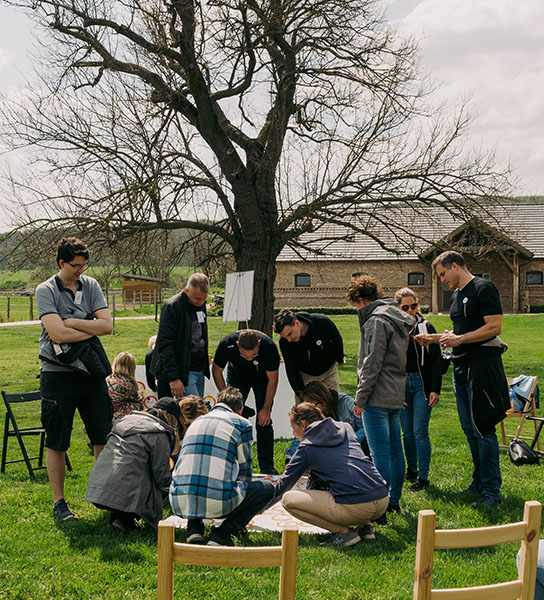
A NEW PERSPECTIVE IN BUSINESS DEVELOPMENT PROGRAMS
The equestrian method brings a new dimension to company programs, trainings, and coaching. It is much more captivating than a traditional training session, resulting in incomparably higher levels of engagement, attention and presence. And without this, there is no progress, if the individual is not open, motivated, or willing, there will be no change. It’s a joy to see what horses bring out of people who have been trained, challenged and developed often to the point of resistance, from fixed situations. They open up a whole new perspective, as they simply are with their 500 pounds and reflect our behaviour back to us without any interest, influence or complication. They teach us a lesson by not cooperating with us out of a mere sense of duty. We must find our balance and learn to exist and communicate with them as whole human beings.
COMMUNITY BUILDING
TEAM BUILDING WITH HORSES
“Working with others is like giving yourself an advantage in a race.“- John C. Maxwell
Horse-assisted team building recharges, entertains and relaxes. It is a profound and liberating experience that, in addition to recharging, helps to assess individual and team resources, eases communication difficulties, helps to develop understanding attention and offers new perspectives for cooperation. The transformation achieved in horse-assisted team building is enhanced by leaving the comfort zone, the closeness to nature, the total involvement and the cathartic experience of interacting with the horse. It synchronises emotions, thoughts and their expression. During the program, participants work simultaneously with their own individual talents and how they can use them to benefit the community. In addition to the goals, the focus is on process, collaboration, and internal and external harmony, leading to a more confident and self-identified presence. The experience is not just stored in the mind, and is therefore more easily recalled in situations where it is needed. In the programs, we tailor the community-building and developmental tasks to the needs of the team, helping them to replace their outdated coping strategies and to creatively take on new challenges.
Upon request, we can also provide accommodation, meals and accompanying activities, for one or more days.
No riding skills are required to participate, the team works with the horses from the ground without sitting on them, guiding, herding, calling them in.
The exercises become more complex, with feedback circles after each exercise led by the trainers to support awareness of the experience.
Stud analogy and adaptivity – what human communities can learn from horses
Horses are herbivorous escape animals. They have been present on earth for 65 million years and have only been under human influence for 6,000 years. Their behaviour has not undergone any significant genetic changes during this time.
They monitor their environment with great sensitivity, and their sense of smell, hearing and sight is much more acute than that of humans. They can sense physiological processes: changes in adrenaline levels, breathing, pulse rate. These changes can be signs of important emotional changes, which horses process as information. If they are threatened by a predator, it is important that they are able to escape quickly and simultaneously, their sensitivity is their ‘superpower.
When they interact with humans, they are watching to see if they are safer if they cooperate, or safer if they run away or take the lead.
For them, safety is about clear signals, consistency and being authentically present and honest.
In nature, they live in a herd where they play different roles. These roles are observer, supportive, non-predator dominant, leader, and predator dominant.
Their cooperation is based on energy conservation and the pursuit of harmony.
They do not fight unnecessarily, always putting the welfare of the whole herd before their individual interests. They communicate their needs immediately and clearly through body language, they are unable to hold back emotions and always give immediate feedback in response to the situation at hand without pre-conditioning.
The species is highly adaptive, easily adapting to environmental changes during evolution. It has evolved from a forest dweller to a steppe animal and has even survived domestication.
Humans first hunted it, then got on its back and caught it in front of a plough.
Until the advent of machines, everyone had some relationship with horses. They helped us to work the land, to travel long distances more quickly, and in wars. Their domestication changed our lives fundamentally.
And in modern times, they help us find our way back to ourselves.
